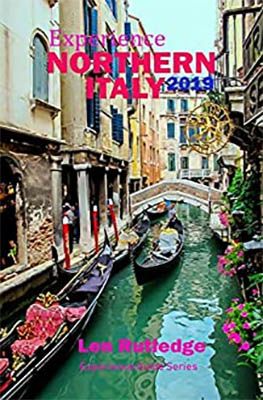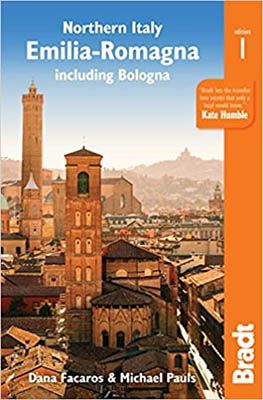At the beginning of October last year, we went on a fantastic tour of the beautiful Adriatic coast of north-eastern Italy. With Ravenna as our home base, we visited beautiful cities in the area, including Bologna. In this beautiful and historical city, we did not have enough eyes to look at everything. There is so much to see that you should definitely take two days for a city trip. Many Italians call this terracotta red city, after Venice, the most beautiful city in Italy with good reason.
Bologna has been inhabited since the 10th century BC. Among others, the Celts, Romans, Huns, Goths, Lombards, Franks, Austrians and French. Each of these peoples has left its traces in the city (still visible). Bologna is also the seat of the oldest university in all of Europe. Even today, a significant part of the population are students.
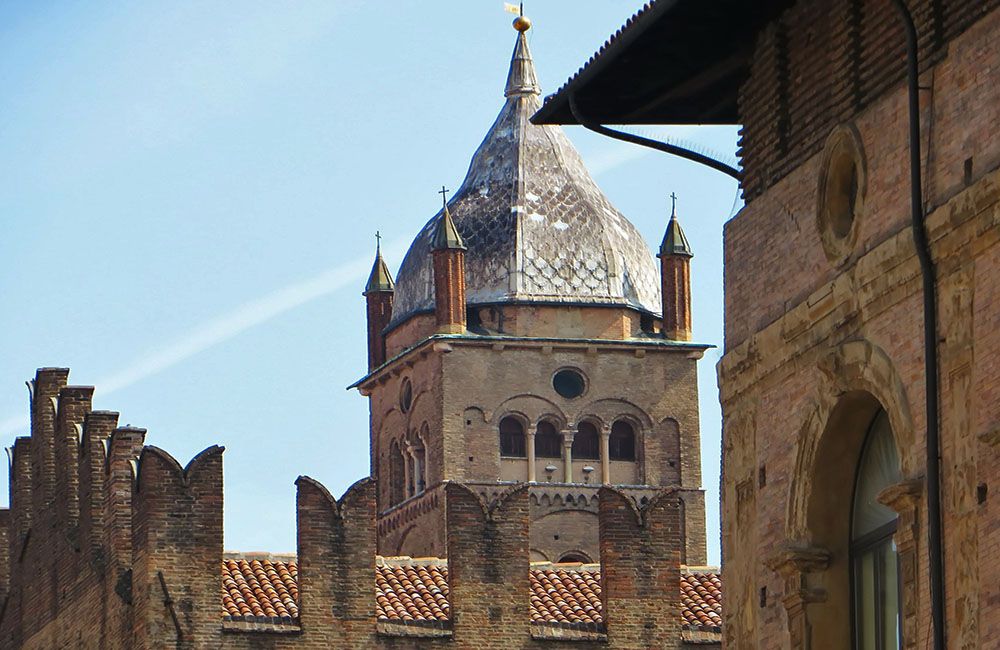
What to see and do on a city trip to Bologna
A good way to get to know a new city quickly is by bike. This is especially true for Bologna, given the size of the city. There are several places where you can hire a bicycle and explore the city on your own. Perhaps it is even more fun to book a bicycle tour with (English) guide. This is possible at Baja Bikes, among others. The most booked tour is the one with a group, which shows you the biggest highlights. The enthusiastic guide has a lot to tell and provides a lot of background information. In just under three hours, you will learn a lot about the history, culture and highlights of the city. An optimal start of your city trip to Bologna!
Naturally, you can also get to know the city perfectly by taking a city walk. The best place to start is at the Bologna Tourist Office in Piazza Maggiore. Take the (free) city map with a walk along the highlights. There are eight sights on it with brief descriptions that are certainly worth a visit. However, the staff can also help you with other, more extensive city walks. Tip: Would you like to explore the city with a guide? Then purchase the Bologna Welcome Card. A city tour is included in the tourist card.
Furthermore, Bologna also has the ideal hop-on-hop-off buses. The red bus leaves from Piazza Maggiore and has many stops. Not only in the old centre but also outside.
These are some of the many highlights that you should not miss, regardless of your means of transport:
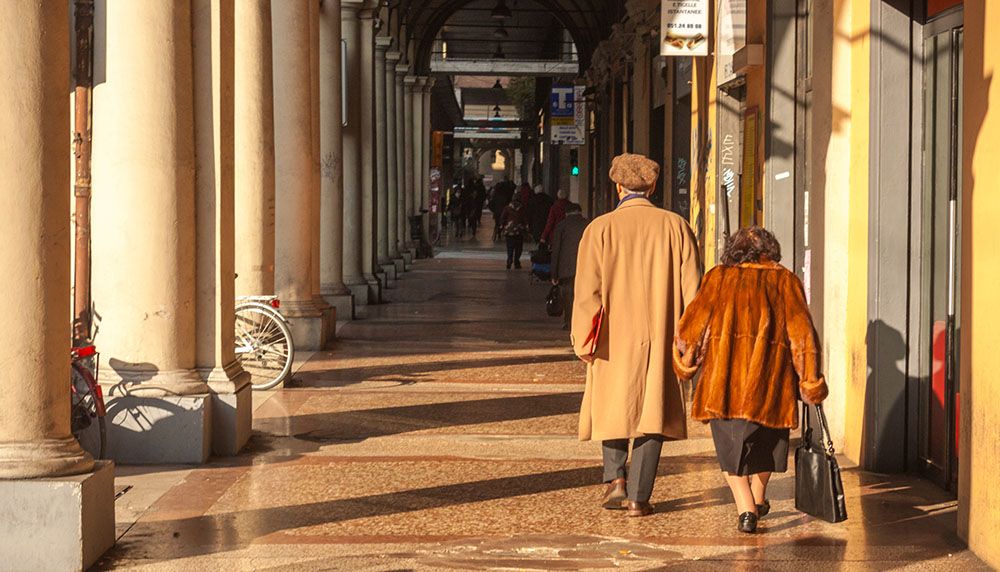
Piazza Maggiore
Piazza Maggiore is Bologna’s large central square and the heart of the city. It is one of the largest and oldest squares in Italy. Most city walks and bicycle tours, as well as the hop-on-hop-off bus, start from this square. And you can find the tourist office there.
The construction of the square started at the beginning of the 13th century. Before that, almost all existing buildings were razed to the ground. Since then, the square has been the centre of Bologna’s political and social life. Until the middle of the 19th century, Piazza Maggiore was one of the largest open-air markets in Europe.
In addition to cafés and terraces, the square is lined with many palaces from the Middle Ages and Renaissance. The oldest is Palazzo del Podestà from the year 1200. The highest Bolognese official used to have his office here. On the square, you will also find St Petronius’ Basilica whose façade was never completely finished. It is definitely worth a visit, among other things because of the world’s largest sundial and a special 15th century fresco. Other palaces are Palazzo del Notai, Palazzo d’Accursio, Palazzo Re Enzo and Palazzo dei Banchi. They are all interesting to see, so plan enough time for the square.
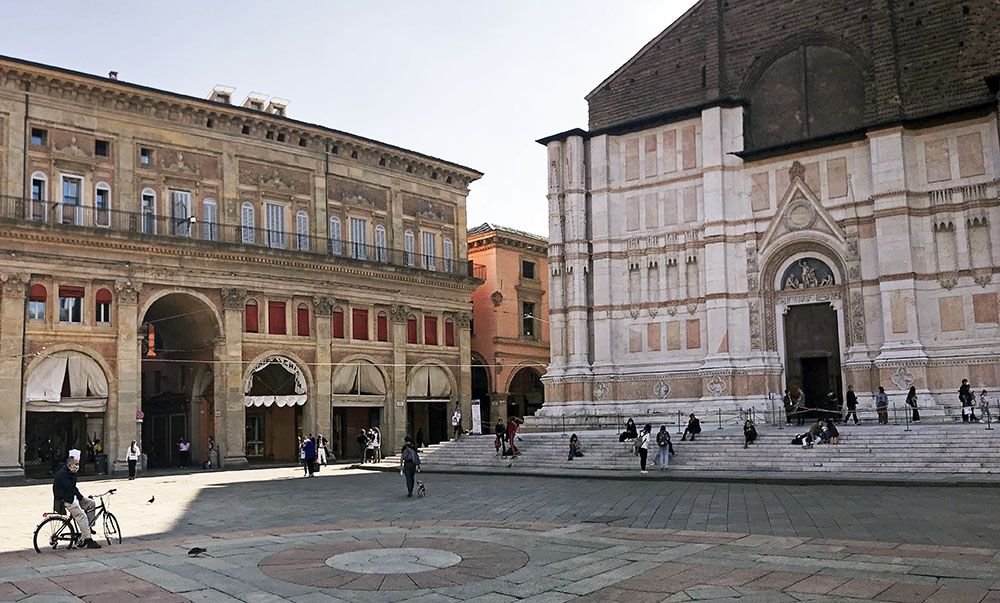
Palazzo dell’Archiginnasio
Just south of Saint Petronius’ Basilica is the Palazzo dell’Archiginnasio. This palace is an absolute must-see in our opinion. It was built in the mid-16th century to house the city’s numerous faculties. Until the early 19th century, the beautiful building remained the medieval headquarters of the University of Bologna.
One of the highlights of the Palazzo dell’Archiginnasio is the all-wood anatomical hall. Here, medical students were taught anatomy at a marble table. Another highlight is the Stabat Matar auditorium where you will find ancient books. This is where Albert Einstein lectured on his theory of relativity.
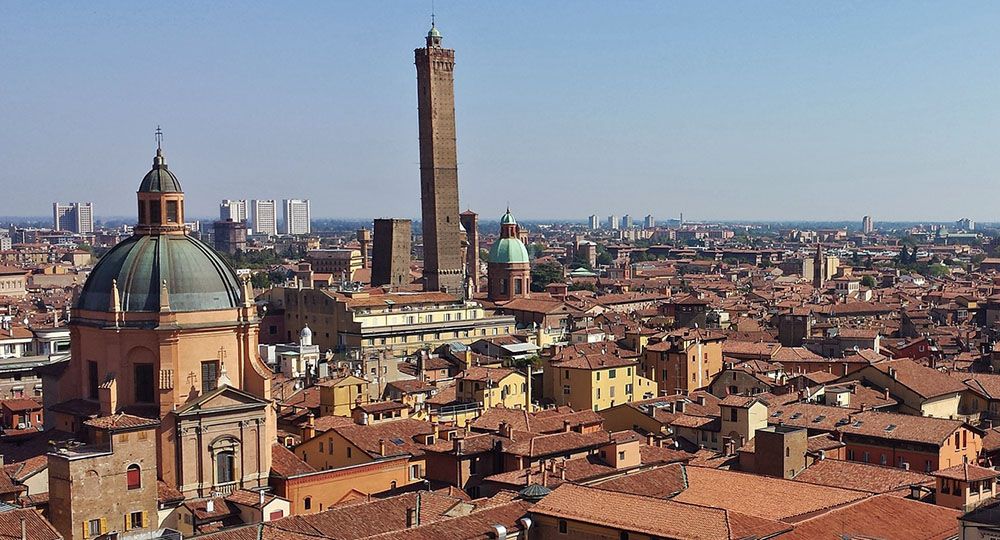
The many towers of Bologna
Bologna is also known as “Turrita” because of the approximately 100 towers that the city centre used to have. Only 24 have survived to this day. One of the most extraordinary towers is the Torre dell’Arengo. This tower from 1453 has the largest bell in Bologna. The bell weighs no less than 5000 kilos. The tower was built without a foundation on top of the Palazzo del Podesta.
Another special tower in Bologna is the Torre Prendiparte. The 60-metre-high tower was built in the 12th century as a defence tower. And admittedly, thanks to the “Bolognese” red and massive bricks, the tower looks like an impregnable fortress. In the mid-18th century, the Prendiparte was also used as an archiepiscopal prison. Reddish inscriptions of prisoners (mainly lamentations) are still visible on some floors. At present, the tower is mainly known for the fantastic view. There is also a B&B in the tower but it seems that you cannot book it at the moment.
Finally, the leaning Garisenda Tower and the even more leaning Asinelli Tower are the icons of Bologna. They are located in the city centre where people used to enter the city via the Via Emilia. The twin towers were built during the Middle Ages. At that time, they had a military function. The recently restored Asinelli Tower is the only one open to the public. To reach the top, you have to climb 498 steps. The ‘work-out’ is immediately forgotten when you see the incredible view. Even my wife, who is afraid of heights, found the climb a highlight of our visit to Bologna.
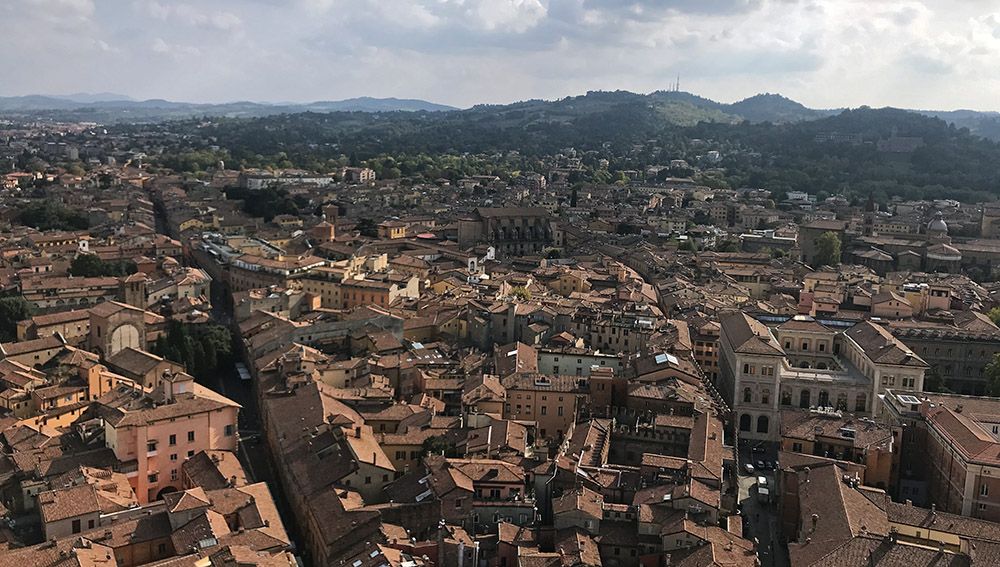
Porticos
Bologna is the city of the so-called ‘portico’: a kind of (covered) colonnade or porch. You have almost 62 kilometres of porticos in the city. Most of them are in the centre, but you can also find them just outside. As of July 2021, 12 kilometres of the network of porticoes have been added to the UNESCO World Heritage List.
The first porticos appeared in the 11th century because of the housing shortage. The upper floors were extended widthwise, but had to be propped up. In the years that followed, the posts, which were initially made of wood, became larger and larger. In order to prevent them from collapsing, a stronger foundation was needed. Bricks were used instead of wood. This is how the arcades came into being that were ultimately known all over the world.
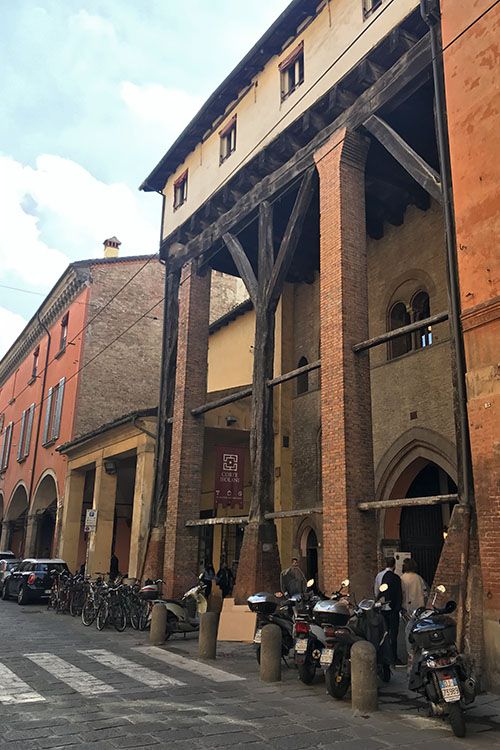
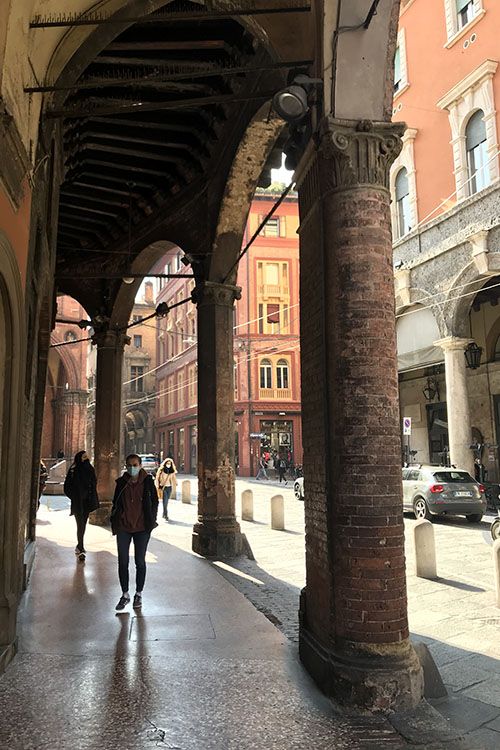
During your city walk through Bologna, you may come across the most extraordinary porticos. A very famous one is the high portico ‘Dei Bastardini’ in Via D’Azeglio. What we consider an impressive portico is the wooden Isolani from the 13th century. The oak wooden pillars are no fewer than 9 metres high! But the most famous is surely the portico of San Luca. This colonnade starts in Via Saragozza and ends at the Basilica of San Luca. With a length of almost four kilometres, the portico is the longest in the world. The walk to the basilica is a tough one because you have to climb quite a bit. But once you reach the destination, the climb is immediately forgotten. The basilica is definitely worth a visit and the views are exceptionally beautiful!
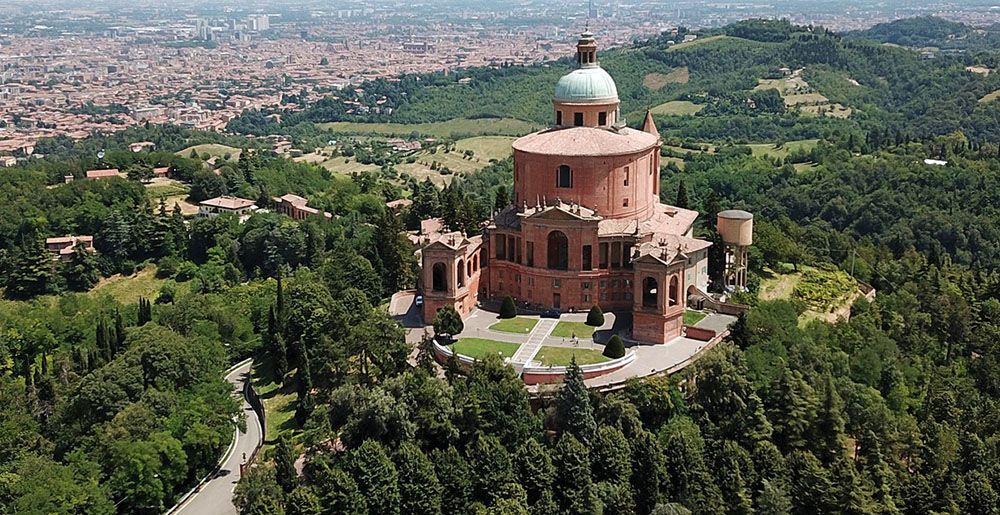
What to see and do in the surroundings of Bologna
We can easily spend days strolling through the beautiful, historical city. Visit some museums and palaces, and of course climb some of the towers. But we can also enjoy the cosy terraces and the many culinary pearls in the city. However, Bologna is more than just one of the best-preserved medieval cities in Italy.
Sports car enthusiasts will find what they are looking for in the Lamborghini Museum in Sant’Agata Bolognese near Modena. And of course in the Enzo Ferrari Museum in Modena itself. Furthermore, 15 kilometres east of Bologna is the small town of Budrio. It is surrounded by a landscape of orchards. The main attraction is the Bentivoglio Castle from the 16th century. A good 20 kilometres south of there, you will find Castel San Pietro Terme. In this town, there are thermal springs and many old churches.
If you go from Castel San Pietro Terme even further to the east, you will arrive in Imola. This city is particularly known for motor sports and car racing though there are also other sights worth visiting. For example, Sforza Castle and several beautiful religious buildings. What’s more, Imola is just a nice, cosy old town with many restaurants and accommodation.
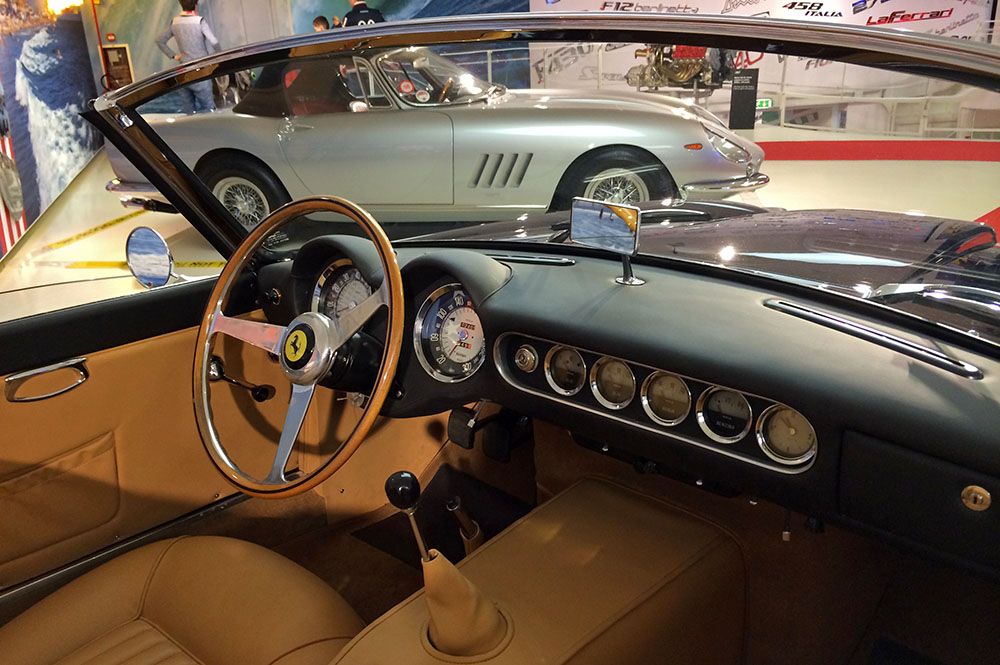
Visiting culinary Bologna: practicalities
Yes: the Bologna Welcome Card is the tourist pass that allows you to visit the most beautiful sights at the cheapest price. The card costs 25 euros per person and is valid for 15 days. The card gives access to many attractions including the Asinelli Tower. A guided city walk is also included. Please note that you can only use the pass once per attraction or activity.
Bologna is easy to reach by train, by (rented) car and by plane (non-stop). If you come by car, parking is a challenge. If you are staying for at least one night, choose a hotel with private parking facilities. Usually, you have to pay extra for this but you do not have to search for a parking space. If you are visiting the city on a day trip, parking outside the city is a good option. You can do this for example at Car Park Tanari. There is plenty of space, it is cheap and there is a shuttle to the centre. Once you are in the centre, you can explore the city further on foot or by bike.
Walking
Bologna is a great city to explore on foot. The streets are well signposted and the city is easy to navigate. It is also a perfect way to find the 'hidden gems'. The sprawling city centre also contains 62 kilometres of ideally covered walkways called porticos. Not only ideal for shelter, but above all to avoid the countless scooters.
Cycling
Bicycles are most popular among Bologna's residents, especially students. You can rent a bike at various locations in the city. For example, you can do this at Baja Bikes. Or at Dynamo, near the train station). You can cycle on the many bicycle paths and along the side of the road. Make sure you lock your bike properly, because they are stolen all over the city.
Bologna is at its best from April to September. It is nice and warm then and very pleasant. In this period, people mainly eat and drink outside on the many piazzas and terraces. In July and August, it can be - for us at least - too hot and stuffy. Many shops and restaurants are also closed then.
The last time we were there was in early October. In spite of the bright sunshine, it soon got cold on the terrace. In the winter, it is of course even colder, but the city is said to be beautiful then. In January and February, for example, you often have cloudless, blue skies. You will need a coat, scarf, hat and gloves during this period.
Bologna is renowned for its hospitality. Bologna's cultural heritage and its wine and food make it an ideal weekend or holiday destination. At different times of the year. We went there for three days in spring ten years ago. The last time in autumn, we spent only one day there. Never been in Bologna before? Then book at least one night! View the wide range of accommodation in Bologna here.
Besides historical gems, Bologna is known for its exquisite cuisine (la cucina Bolognese). Bologna is generally considered the gastronomic centre of Italy for good reason. The Bolognese, like most Italians, use fantastic local products and are very inventive about it.
There are a lot of good eateries and restaurants in the city. So many, in fact, that if we were to list our top 5, we would be doing injustice to many - possibly even better - restaurants. Instead, take a look at this list of restaurants in Bologna. Or just walk along the many establishments to see if there is something to your liking. But remember: the interior of an Italian restaurant says nothing about the quality of the food. Go rather on the apparent number of Italians.

